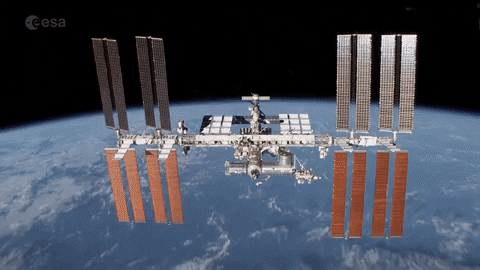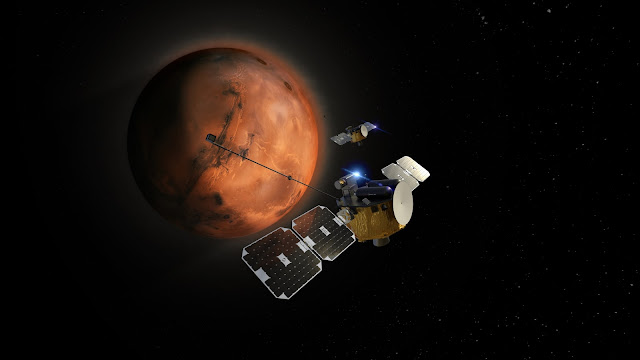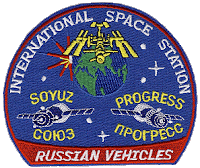NASA / ESA - Hubble Space Telescope (HST) patch.
Feb 9, 2023
New images of Saturn from NASA's Hubble Space Telescope herald the start of the planet's "spoke season" surrounding its equinox, when enigmatic features appear across its rings. The cause of the spokes, as well as their seasonal variability, has yet to be fully explained by planetary scientists.

Image above: NASA's Hubble Space Telescope has observation time devoted to Saturn each year, thanks to the Outer Planet Atmospheres Legacy (OPAL) program, and the dynamic gas giant planet always shows us something new. This latest image heralds the start of Saturn's "spoke season" with the appearance of two smudgy spokes in the B ring, on the left in the image. The shape and shading of spokes varies – they can appear light or dark, depending on the viewing angle, and sometimes appear more like blobs than classic radial spoke shapes, as seen here. The ephemeral features don't last long, but as the planet's autumnal equinox approaches on May 6, 2025, more will appear. Scientists will be looking for clues to explain the cause and nature of the spokes. It's suspected they are ring material that is temporarily charged and levitated by interaction between Saturn's magnetic field and the solar wind, but this hypothesis has not been confirmed. Image Credits: NASA, ESA, and Amy Simon (NASA-GSFC); Image Processing: Alyssa Pagan (STScI).
Like Earth, Saturn is tilted on its axis and therefore has four seasons, though because of Saturn's much larger orbit, each season lasts approximately seven Earth years. Equinox occurs when the rings are tilted edge-on to the Sun. The spokes disappear when it is near summer or winter solstice on Saturn. (When the Sun appears to reach either its highest or lowest latitude in the northern or southern hemisphere of a planet.) As the autumnal equinox of Saturn's northern hemisphere on May 6, 2025, draws near, the spokes are expected to become increasingly prominent and observable.
The suspected culprit for the spokes is the planet's variable magnetic field. Planetary magnetic fields interact with the solar wind, creating an electrically charged environment (on Earth, when those charged particles hit the atmosphere this is visible in the northern hemisphere as the aurora borealis, or northern lights). Scientists think that the smallest, dust-sized icy ring particles can become charged as well, which temporarily levitates those particles above the rest of the larger icy particles and boulders in the rings.
The ring spokes were first observed by NASA's Voyager mission in the early 1980s. The transient, mysterious features can appear dark or light depending on the illumination and viewing angles.
"Thanks to Hubble's OPAL program, which is building an archive of data on the outer solar system planets, we will have longer dedicated time to study Saturn’s spokes this season than ever before," said NASA senior planetary scientist Amy Simon, head of the Hubble Outer Planet Atmospheres Legacy (OPAL) program.

Hubble Space Telescope (HST). Animation Credits: NASA/ESA
Saturn's last equinox occurred in 2009, while NASA's Cassini spacecraft was orbiting the gas giant planet for close-up reconnaissance. With Cassini's mission completed in 2017, and the Voyager spacecrafts long gone, Hubble is continuing the work of long-term monitoring of changes on Saturn and the other outer planets.
"Despite years of excellent observations by the Cassini mission, the precise beginning and duration of the spoke season is still unpredictable, rather like predicting the first storm during hurricane season," Simon said.
While our solar system's other three gas giant planets also have ring systems, nothing compares to Saturn's prominent rings, making them a laboratory for studying spoke phenomena. Whether spokes could or do occur at other ringed planets is currently unknown. "It's a fascinating magic trick of nature we only see on Saturn – for now at least," Simon said.
Hubble's OPAL program will add both visual and spectroscopic data, in wavelengths of light from ultraviolet to near-infrared, to the archive of Cassini observations. Scientists are anticipating putting these pieces together to get a more complete picture of the spoke phenomenon, and what it reveals about ring physics in general.
Saturn's Rings Are Acting Strange
Video above: Since their discovery by NASA's Voyager mission in the 1980s, temporary "spoke" features across Saturn's rings have fascinated scientists, yet eluded explanation. Saturn's upcoming autumnal equinox of the northern hemisphere on May 6, 2025, means that spoke season has come again. NASA's Hubble Space Telescope will be on the job studying the spokes, thanks to time dedicated to Saturn in the mission’s ongoing Outer Planet Atmospheres Legacy (OPAL) program. Image Credits: NASA's Goddard Space Flight Center; Lead Producer: Paul Morris.
The Hubble Space Telescope is a project of international cooperation between NASA and ESA. NASA's Goddard Space Flight Center in Greenbelt, Maryland, manages the telescope. The Space Telescope Science Institute (STScI) in Baltimore conducts Hubble science operations. STScI is operated for NASA by the Association of Universities for Research in Astronomy, in Washington, D.C.
Related links:
Hubble Space Telescope (HST): https://www.nasa.gov/mission_pages/hubble/main/index.html
Saturn: http://www.nasa.gov/saturn
Image (mentioned), Animation (mentioned), Video (mentioned), Text, Credits: NASA/Andrea Gianopoulos/GSFC/Amy Simon/Claire Andreoli/STScI/Leah Ramsay and Ray Villard.
Best regards, Orbiter.ch













































